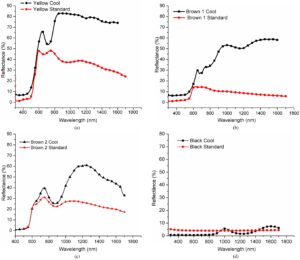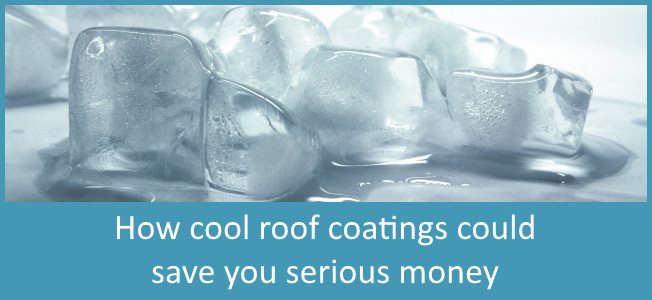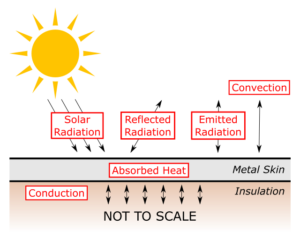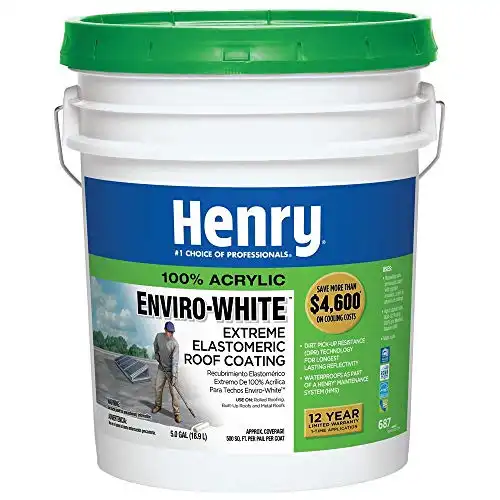You may have heard about cool roof coatings or cool roof paint as a way to noticeably lower the temperature of your container. But what exactly are these coatings, how do they work, and how are they different than normal paint?
As you might already know, one of the challenging parts of living or working inside a shipping container is keeping the interior space at a comfortable temperature. For many geographic locations, during the majority of the year, the biggest challenge is keeping the container cool.
In other articles, we discuss how air conditioning, ventilation, and insulation are ways to reduce the temperature of a container home. However, there is another method that deserves discussion: cool roof coatings. These coatings allow you to economically reduce the surface temperature of your container by potentially dozens of degrees and take only a few hours to install.
And it’s not just us talking about cool roofs. Energy Star, the US Green Building Council’s LEED certification program, and California’s Title 24 Building Energy Efficiency Standards all reference cool roofs as a way to save energy.
A cool roof coating is most applicable when the top of your container IS your roof. For those who choose to build a roof on top of their container, depending on the design, a cool roof coating may not be necessary. If there is an air gap below your roof that’s open to the environment, you’ll see little improvement from a cool roof coating. But if your roof forms an enclosed attic space over your container, a cool roof coating may still be relevant.
A cool roof coating may look similar to paint, but actually has specific ingredients with properties that make it very effective at reflecting and emitting thermal radiation. For more on what that means and how it benefits you, read on!
What is a cool roof coating?
A cool roof coating has several similarities to paint:
- It can usually be applied the same ways, with rollers, brushes, or a spray rig (depending on product type)
- It comes in liquid form in a container similar to what is used to purchase paint
- Once applied, they look more or less the same
However, there several important differences between a cool roof coating and paint:
- While it has an aesthetic purpose as well, the primary goal is not for appearance, but for thermal performance
- It is much thicker and able to better withstand natural and manmade wear/tear
- It contains special pigments designed to reflect and emit specific wavelengths of electromagnetic (specifically thermal) radiation
That last bullet is the most important one as you might have guessed!
While there are other cool roof products like roof tiles, we’re focusing only on the liquid applied coatings here.
How does a cool roof coating work?
Like insulation, a cool roof coating is passive, meaning it doesn’t require any additional energy to operate. Compare that to something like air conditioning, which is active, and requires the addition of energy in the form of electricity to function.
All other things being equal, maximizing your passive cooling is a great way to be more eco-friendly and save yourself some money. We’ll explain how in a bit.
We talked about how thermal energy is a type of non-ionizing radiation in our article on heat transfer. In short, the sun is sending out energy (called solar radiation) at a variety of wavelengths, some of which corresponds to light, some of which corresponds to heat, and some of which corresponds to other things.
Cool roof coatings target the wavelengths that transmit heat, which we’ll call thermal energy. The coatings are specially formulated to both reflect and emit thermal energy, and little notice is paid to their effect on the other types of radiation (like visible light, radio waves, and others).
Before we go further, let’s visualize the topics we’re about to discuss, then break each type of energy transfer down afterward.
Solar Radiation
As previously mentioned, this is energy coming directly from the sun, also called Solar Irradiance.
Reflected Radiation
- Inbound: Every object around you is reflecting some radiation from both other objects and the sun, and some of that is reflected toward your container.
- Outbound: The cool roof coating has a performance measure called Reflectivity or Reflectance. It tells us how much inbound energy can be reflected back out, much like a mirror but for heat. The majority of the benefit of a cool roof comes from its enhanced reflectivity.

Emitted Radiation
- Inbound: Every object around you is emitting radiation, and some of that is emitted toward your container.
- Outbound: The cool roof coating has a performance measure called Emissivity. It tells us how much internal, absorbed thermal energy can be emitted back out into the environment. For instance, if you were in a dark room, sitting across from a warm box, you would feel more of that box’s heat radiated toward you if the box was black rather than white because black objects tends to have higher emissivities.
Note: The Solar Reflectance Index is a number you might also see. It is a composite measurement computed via an algorithm that’s inclusive of both the reflectivity and emissivity of a material.
Convection
- Inbound: At certain times in certain geographic areas, warmer air can touch the container skin and transfer heat to it.
- Outbound: At other times and places, the container skin may transfer heat to the cooler air.
Conduction
- Inbound: Heat from the container skin flows into your insulation (and eventually, the interior of your container) if the interior is cooler than the exterior.
- Outbound: Heat from the interior flows into your insulation (and later, into the container skin) if the interior is warmer than the exterior.
Absorbed Heat
When we take the inbound energy directly from the sun plus the reflected and emitted energy from other objects, then subtract the energy reflected and emitted by the container skin, and also subtract (or add, depending on the direction of heat flow) the conducted heat coming from or going to the insulation, we’re left with the absorbed energy or heat. The absorbed heat is directly related to the temperate increase of the container.
When would you not want a cool roof coating?
We’ll be upfront: if your roof is already white or lightly colored, clean, and in good shape, it’s likely that whatever small benefits you might gain from a cool roof coating wouldn’t be worth the time and expense of adding it. But for everyone else with a darker roof or a dirty, peeling roof – cool roof coatings might be an idea worth considering.
In addition, it’s fairly logical to think that if you live in a location where it is cold most of the year, a cool roof coating may not be for you. Instead, you want to maximize the heat absorption of your containers, so you can minimize the additional heat needed (via heats, stoves, etc.) to keep you warm.
However, there are some other factors at play that can minimize the negative impact a cool roof coating would have on your heating bill.
First, the sun is at a lower angle of incidence in winter, meaning it has noticeably less radiant energy than in the summer. It also means that more of the sun is hitting nearby trees, buildings and the sides of your container instead of coming straight down onto your roof.
Second, if you live in an area with snow, accumulated snow is going to make your roof coating performance irrelevant since it will be covered.
If you live in a mixed climate, the decision on whether a cool roof coating is right for you is more nuanced. It may be helpful to determine the number of heating vs cooling degree days (HDD vs CDD) that apply to your location as you think through the decision.
Degree days measure how cold (HDD) or hot (CDD) a location is by comparing the average outdoor temperatures recorded for a location to a standard or base temperature, usually around 65°F (18.3°C). For example, if the average temperature at your location on a particular day was 80°F, that day equates to 15 CDD’s. More extreme outside temperatures mean more degree days, which in turn mean a higher level of energy use for heating and cooling.
Should you use a cool roof coating on the side walls of your container home?
Depending on your latitude and the shade your container home gets at different times of day, using a cool roof coating on the walls may have a measurable impact as well. However, any potential benefit (if there is one) is quite unique to each home and building site. The more direct sunlight a particular wall gets, and the closer the angle of incidence is to 90 degrees, the more impact it will have.
Regardless of the potential benefit, you certainly need to factor in aesthetics. A coating on the roof may not be noticeable, but a coating on the walls will be obvious. So you might be able to get by with a white coating on the roof, but you may need a colored coating on the walls. Luckily, cool coatings are available with many colors as well, but before paying a premium, make sure you have the sun exposure to make it worth it.
Why not just use white paint instead of a cool roof coating?
As we just mentioned, cool roof coatings don’t have to be white. Due to their use of special pigments and the fact that they are primarily dealing with radiation outside the visible light wavelengths, cool roofs can actually be many different colors. However, lighter colors do perform better than darker colors, all other things being equal.
Another thing to take into account is the visible reflection from ordinary white paint. If your house is multilevel or you have multilevel neighbors nearby, strong visible reflections may be present at certain times of day through 2nd and 3rd story windows, which can be quite problematic. Using a non-white cool roof coating can give some of the performance benefits with less of the annoying reflections.
Finally, regular paint is thinner and less weather resistant than a cool roof coating, which is certainly something to consider. A roof is an extreme environment with some of the harshest exposure to the elements, so a thick, durable, purpose-built coating is usually a better option. And let’s be honest, getting up on your roof to paint (or paying someone else to do it for you) is not something you want to do more often than you have to.
How can a cool roof coating save me money?
Cool roofs offer you the chance to save money in two ways:
- In the right circumstances, the effect of the cool roof might be enough to mean you can install a smaller air conditioning unit than you otherwise would. However, knowing when you have the right circumstances to do that is pretty complicated. Experienced air conditioning companies have access to expensive software that can model the AC requirements for your home and tell you what size unit you need, but this is really beyond the scope of a DIY project other than a trial-and-error experiment.
- Using the same air conditioning unit, with a cool roof, the unit may end up needing to run less often to keep your house at the same temperature, saving you money on your electrical bill. However, remember that for humid areas, you may have to run your AC just to keep the relative indoor humidity down, which could negate the benefit slightly.
This calculator (only applicable to US locations) can help quantify the financial impact of a cool roof.
To help offset the upfront cost of adding a cool roof, many utility companies have started to offer rebates to homeowners. Some are listed here, but we’d encourage you to also reach out to your local utility providers as well and see if they offer any incentives.
How do I know which cool roof coating to get?
Cool roof coating performance is driven by the criteria we previously discussed: Reflectivity and Emissivity, sometimes combined into a measure known as the Solar Reflectance Index. Any reputable manufacturer should be upfront about sharing these number for their product. The CoolRoofs.org product directory is also a good place to look up the specifications if you know the name of a product but don’t have the marketing materials handy.
You also have a choice of coating types. The two main options are acrylic and silicone. While products from both materials have similar thermal performance, they differ in several other important ways:
Acrylic (Sometimes called ‘Elastomeric’) Cool Roof Coatings
- Physical Properties: Water-based (easy clean up with water), great durability and dirt pickup resistance but can lose thickness due to weathering over time
- Application: Sensitive to weather at the time of application to get the right adhesion and requires multiple coats to get the required material thickness
- Ponding: Cannot withstand ponding water (typically defined as water standing for over 48 hours) and will eventually delaminate and peel up from the metal roof below
Silicone Cool Roof Coatings
- Physical Properties: Non-water based (clean up requires a solvent like mineral spirits), and typically include volatile organic compounds (VOCs). Less durable. More prone to pick up dirt and grime and can sometimes slightly yellow in the sun over time (all of which reduce thermal performance).
- Application: Can typically be applied in a single coat all at once, but is a little more sticky and messy. Has been known to start ‘setting-up’ on humid days while in an open bucket before application, so it’s sensitive to weather at the time of application as well.
- Ponding: While not completely waterproof, is noticeably more water-resistant than acrylic products and is better able to withstand ponding or pooling water
What we recommend
In short, acrylic is better than silicone in most ways except for the handling of ponding water. Ultimately, a container roof is a flat roof, and thus ponding water can be a concern. Dump some water on your container roof and see how it drains, especially if it is a used container and may have some roof dents. You may need to use a hydraulic jack or a sledgehammer to push out some of the dents. Due to the narrow width of containers, even if ponding were to occur it hopefully won’t be much. For applications where the roof is fairly flat and uniform, and no substantial ponding occurs with your water test, a high-quality acrylic cool roof coating should work well.
If you have multiple containers joined together and no draining in between containers, you’ve effectively made your roof much wider and more prone to ponding. For these situations, or in environments with a lot of rain, you may want to consider a silicone cool roof coating just to be safe.
Either way, we recommend using a premium cool roof coating from an established manufacturer, and avoiding the products out there from unknown brands.
Henry Enviro-White is a great choice for an acrylic product. You can check out product data and MSDS information here.
If you do decide that you need a silicone cool roof coating, Henry Tropi-cool or something similar would be a good choice.
Do cool roof coatings with ceramic beads offer increased performance?
If you do a little research into cool roof coatings, you’ll start to see a number of products advertising the addition of tiny ceramic spheres or beads into the coating. Supposedly, the beads work to increase the reflectivity of the coating while also reducing the absorbed heat through less conduction.
As with other categories of building products, there are some vendors that are either dishonest or unknowledgeable and try to sell you on products that don’t really work as advertised (We’re looking at you, foil-faced bubble wrap).
A study by researchers at the Oak Ridge National Laboratory found that the ceramic beads offered basically no performance improvement in reflectivity or resistance. In fact, the highest performing product in the test didn’t have ceramic beads at all.
Based on the results of the study, we don’t recommend paying extra for a product with ceramic beads.
Conclusion
As you can see, a cool roof coating is certainly an option to consider as you plan your container home project, or even contemplate an upgrade to an existing container home. With just a little bit of money and a few hours of work, you can noticeably lower the external temperature of your container. Exactly how that might correlate with a reduction in utility bills depends on a variety of factors like your geography, house design, amount of insulation, etc. However, we encourage all current and prospective container homeowners to at least consider a cool roof coating for their project.
If you’d like to learn more about cool roof coatings, these are two excellent resources: https://www.coolrooftoolkit.org/ and https://coolroofs.org/






2 Responses
Thank you so much for putting out this article, it helped me so much .
You’re welcome, and great to hear that you benefited from it!